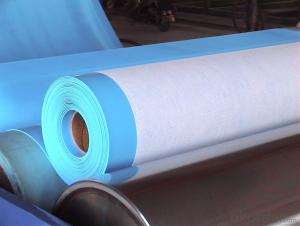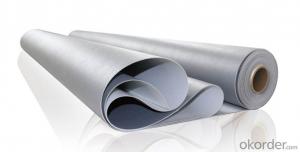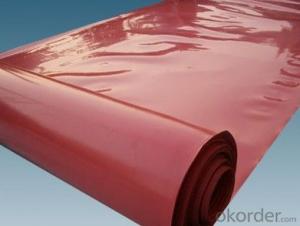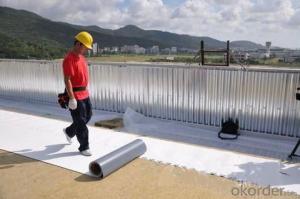TPO Waterproof Membrane for Roofing Construction
- Loading Port:
- Qingdao
- Payment Terms:
- TT or LC
- Min Order Qty:
- 2000 m²
- Supply Capability:
- 800000 m²/month
OKorder Service Pledge
OKorder Financial Service
You Might Also Like
Description Of TPO Waterproof Membrane for Roofing Construction:
Thermoplastic polyolefin (TPO) membrane is based on polypropylene and EP (ethylene-propylene) rubber polymerized together by using state-of-the-art polymer manufacturing technology. This technology enables TPO membranes flexible at low temperatures without the use of polymeric or liquid plasticizers.TPO membranes fall into two main types: Homogeneous TPO & Reinforced TPO. Reinforced TPO has a polyester mesh layer in the middle, which provides reinforced membranes with high breaking and tearing strength and puncture resistance."
Main Features of TPO Waterproof Membrane for Roofing Construction:
- Easy installation with good system integrity, need few accessories
- High tensile and tear strength, puncture resistance
- No plasticizer, heat aging and UV resistance, durable
- Hot-air welding, rapid welding speed, high peel strength (two times of PVC)
-No chlorine, 100% recyclable, environment friendly
- Durable hot-air welding performance and convenient maintainance
- Smooth surface, unfading and stain resistance
Specifications of TPO Waterproof Membrane for Roofing Construction:
| Type | Thickness (mm) | Weight (kg/sqm) | Roll Size (m) | Colors | 20ft Container |
| Homogeneous TPO waterproof membrane | 1.0 mm | 1.63kg/sqm | 2.05m x 20m | White/ Grey | 14000 sqm |
| 1.2 mm | 1.83kg/sqm | 2.05m x 20m | White/ Grey | 12000 sqm | |
| 1.5 mm | 2.24kg/sqm | 2.05m x 20m | White/ Grey | 10000 sqm | |
| 2.0 mm | 2.30kg/sqm | 2.05m x 20m | White/ Grey | 9000 sqm | |
| Reinforced TPO waterproof membrane | 1.2 mm | 1.83kg/sqm | 2.05m x 20m | White/ Grey | 12000 sqm |
| 1.5 mm | 2.24kg/sqm | 2.05m x 20m | White/ Grey | 10000 sqm | |
| 2.0 mm | 2.30kg/sqm | 2.05m x 20m | White/ Grey | 9000 sqm |
Applications of TPO Waterproof Membrane for Roofing Construction:
- Roof construction & steel structure of both industrial and civil engineering
- Underground engineering, such as subways, tunnels, air Raid shelter, etc.
- Sewage treatment, dam, reservoir and basement, grain storehouse, etc.
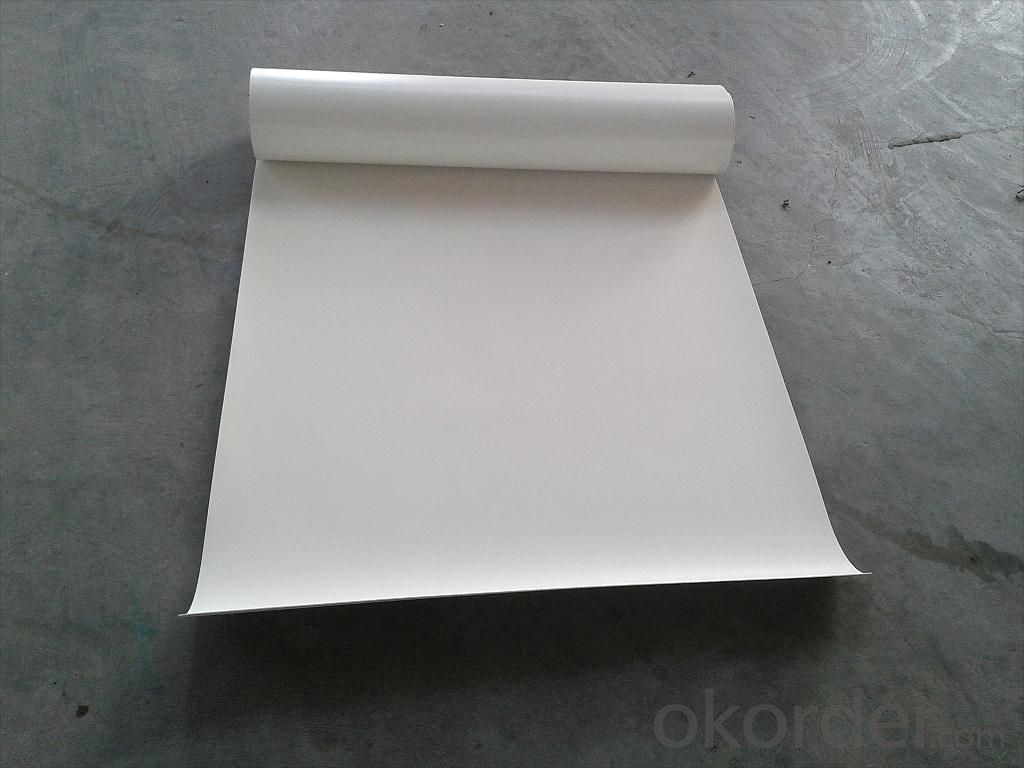
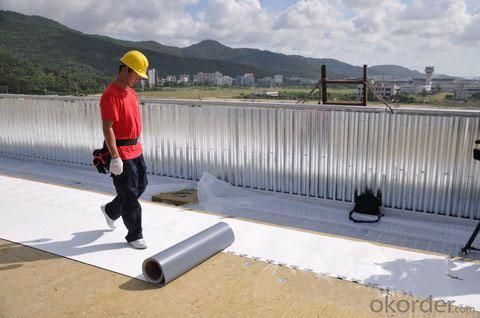
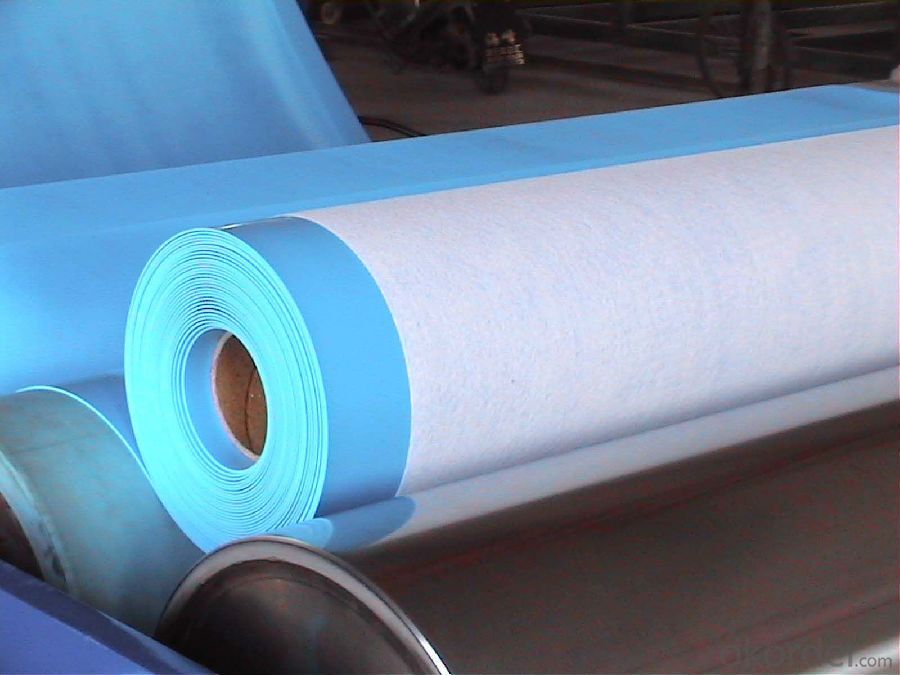
FAQ:
1. What are we supplying?
We are specialized in producing TOP membrane, Colorful Asphalt Roof Shingle, SBS/APP modified bitumen waterproof membrane, Self adhesive bitumen waterproof membrane, PVC waterproofing membrane, EPDM rubber roofing membrane, Single Component Polyurethane Waterproof Coating, and Spray Polyurea Waterproof Coating.
2. How Many years experience do we have?
We have been exported to more than 20 countries in the past 15 years.
3. How long do we usually reply your request?
We always reply our customer within 24 hours.
- Q:Can a waterproofing membrane be painted or coated?
- Indeed, it is possible to paint or coat a waterproofing membrane. However, it is crucial to utilize a paint or coating specifically formulated for application on waterproofing membranes. Typically, these types of paints or coatings possess elastomeric properties, enabling them to stretch and flex along with the membrane, preventing any cracking or peeling. Moreover, it is vital that the paint or coating is compatible with the material of the waterproofing membrane to ensure proper adhesion and long-lasting results. Prior to applying any paint or coating, it is advisable to thoroughly clean and prepare the surface in accordance with the manufacturer's instructions. Additionally, adhering to the recommended application process and allowing ample time for the paint or coating to dry and cure is of utmost importance. Overall, painting or coating a waterproofing membrane can enhance its visual appeal, offer added protection against UV rays and environmental elements, and prolong its lifespan.
- Q:Are waterproofing membranes resistant to punctures?
- Waterproofing membranes are created to resist punctures. These membranes are typically constructed from strong materials like polyvinyl chloride (PVC), thermoplastic olefin (TPO), or ethylene propylene diene terpolymer (EPDM), which are renowned for their durability and ability to endure external pressures. Moreover, polyester or fiberglass is often incorporated into the waterproofing membranes to further strengthen their resistance to punctures. Nevertheless, it is crucial to acknowledge that while these membranes are designed to be highly resistant to punctures, they can still be vulnerable to damage if exposed to sharp objects or excessive force. Therefore, it is imperative to handle and install these membranes with caution in order to uphold their integrity and effectiveness.
- Q:Is a waterproofing membrane suitable for below-grade applications?
- A waterproofing membrane is a suitable choice for below-grade applications, where the areas are situated beneath ground level, like basements or foundations. These regions are susceptible to water infiltration and moisture problems, which can result in harm and structural issues. The purpose of a waterproofing membrane is to prevent water from entering and act as a barrier against moisture. It can be applied either on the exterior or interior surface of the below-grade structure, creating a continuous and long-lasting seal. This membrane effectively prevents water from seeping into the below-grade area, ensuring a dry and stable environment. It is crucial to utilize a waterproofing membrane in below-grade applications to safeguard the structure against water damage, the growth of mold, and other associated concerns.
- Q:Does a waterproofing membrane require any specific primers or bonding agents for installation?
- Yes, a waterproofing membrane often requires specific primers or bonding agents for proper installation. These primers or bonding agents are designed to ensure proper adhesion between the membrane and the substrate, enhancing the overall effectiveness and longevity of the waterproofing system. The type of primer or bonding agent required may vary depending on the specific membrane and substrate materials being used. It is important to consult the manufacturer's guidelines or seek advice from a waterproofing professional to determine the appropriate primer or bonding agent for your specific project to ensure a successful installation.
- Q:Are there any specific considerations for installing a waterproofing membrane on precast concrete surfaces?
- Yes, there are specific considerations for installing a waterproofing membrane on precast concrete surfaces. Here are a few key points to keep in mind: 1. Surface Preparation: Before applying the waterproofing membrane, it is crucial to prepare the precast concrete surface properly. This may involve cleaning the surface, removing any loose particles, and ensuring that it is dry and free from any contaminants. 2. Compatibility: It is important to choose a waterproofing membrane that is compatible with precast concrete surfaces. Some membranes may not adhere well or may not provide effective waterproofing on this type of substrate. Therefore, it is essential to select a membrane specifically designed for use on precast concrete. 3. Adhesion: Ensuring proper adhesion of the waterproofing membrane to the precast concrete surface is vital. The manufacturer's instructions should be followed carefully, including any surface priming or preparation requirements for optimal adhesion. Proper adhesion will help prevent any water infiltration or damage to the concrete. 4. Joint Treatment: Precast concrete surfaces often have joints between panels or other components. These joints need to be properly treated to maintain the waterproofing integrity of the system. This may involve using joint sealants or tapes specifically designed for waterproofing purposes. 5. Durability: Consider the durability and longevity of the waterproofing membrane. Precast concrete surfaces are often exposed to various weather conditions and environmental factors. Therefore, it is crucial to select a membrane that can withstand these conditions and provide long-term protection against water penetration. 6. Quality Assurance: It is recommended to work with experienced professionals or certified installers to ensure the proper installation of the waterproofing membrane on precast concrete surfaces. This will help to minimize any potential installation errors and ensure that the waterproofing system performs as intended. By considering these specific considerations, the installation of a waterproofing membrane on precast concrete surfaces can help protect the concrete from water damage and extend its lifespan.
- Q:Can a waterproofing membrane be used for swimming pool decks and patios?
- Swimming pool decks and patios are commonly subjected to water exposure, which can cause damage. To counter this, a waterproofing membrane can be utilized. This membrane serves as a shield to prevent water penetration and safeguard the underlying structure. Whether it's due to splashing or rainfall, these areas are prone to water-related issues like cracking, mold growth, and deterioration. By applying a waterproofing membrane, you can effectively protect your pool deck or patio from such problems. This protective barrier hinders water from seeping into the concrete or other materials, thus prolonging the lifespan of these surfaces. To guarantee optimum performance and durability, it is crucial to select a high-quality, outdoor-specific waterproofing membrane.
- Q:Can a waterproofing membrane be used in cold climates?
- Indeed, a waterproofing membrane is suitable for use in cold climates. It is highly advisable to utilize a waterproofing membrane in cold climates to safeguard structures from moisture damage caused by snow, ice, and freezing temperatures. These membranes are engineered to possess flexibility and durability, enabling them to endure extreme temperature fluctuations without experiencing cracks or deterioration. They establish a barrier that thwarts water from permeating the structure, a critical factor in cold climates where water can freeze and expand, resulting in substantial harm to buildings and infrastructure. Additionally, certain waterproofing membranes are specifically formulated to excel in cold weather conditions, offering heightened resistance to freeze-thaw cycles and ensuring long-term protection against water infiltration. Therefore, it is imperative to employ a high-quality waterproofing membrane in cold climates to uphold the integrity and longevity of structures.
- Q:Can a waterproofing membrane be used on asphalt surfaces?
- Yes, a waterproofing membrane can be used on asphalt surfaces. Waterproofing membranes are often used to protect various surfaces, including asphalt, from water damage. They create a barrier that prevents water from seeping into the asphalt, reducing the risk of cracks, deterioration, and other forms of damage caused by moisture.
- Q:Are waterproofing membranes resistant to mineral oils?
- Waterproofing membranes can vary in their resistance to mineral oils. Some waterproofing membranes are specifically designed to be resistant to mineral oils, while others may not be. It is important to check the specifications and product information provided by the manufacturer to determine the resistance of a particular waterproofing membrane to mineral oils. Additionally, it is recommended to consult with a professional or the manufacturer directly for specific guidance on the compatibility of a waterproofing membrane with mineral oils in your specific application.
- Q:Can a waterproofing membrane be used in mining or excavation projects?
- Yes, a waterproofing membrane can be used in mining or excavation projects. Waterproofing membranes are designed to prevent the penetration of water or other liquids, making them suitable for protecting underground structures, tunnels, or mining areas from water ingress. They can help to maintain the stability and integrity of the excavation site, preventing water-related damages and ensuring safety.
1. Manufacturer Overview |
|
|---|---|
| Location | |
| Year Established | |
| Annual Output Value | |
| Main Markets | |
| Company Certifications | |
2. Manufacturer Certificates |
|
|---|---|
| a) Certification Name | |
| Range | |
| Reference | |
| Validity Period | |
3. Manufacturer Capability |
|
|---|---|
| a)Trade Capacity | |
| Nearest Port | |
| Export Percentage | |
| No.of Employees in Trade Department | |
| Language Spoken: | |
| b)Factory Information | |
| Factory Size: | |
| No. of Production Lines | |
| Contract Manufacturing | |
| Product Price Range | |
Send your message to us
TPO Waterproof Membrane for Roofing Construction
- Loading Port:
- Qingdao
- Payment Terms:
- TT or LC
- Min Order Qty:
- 2000 m²
- Supply Capability:
- 800000 m²/month
OKorder Service Pledge
OKorder Financial Service
Similar products
New products
Hot products
Hot Searches
Related keywords
